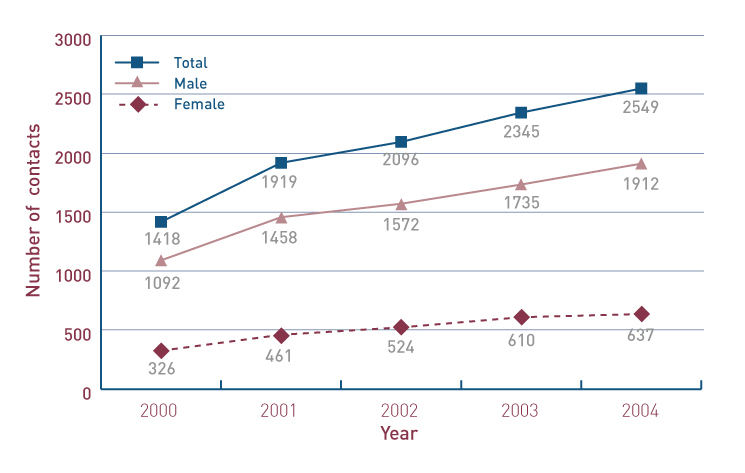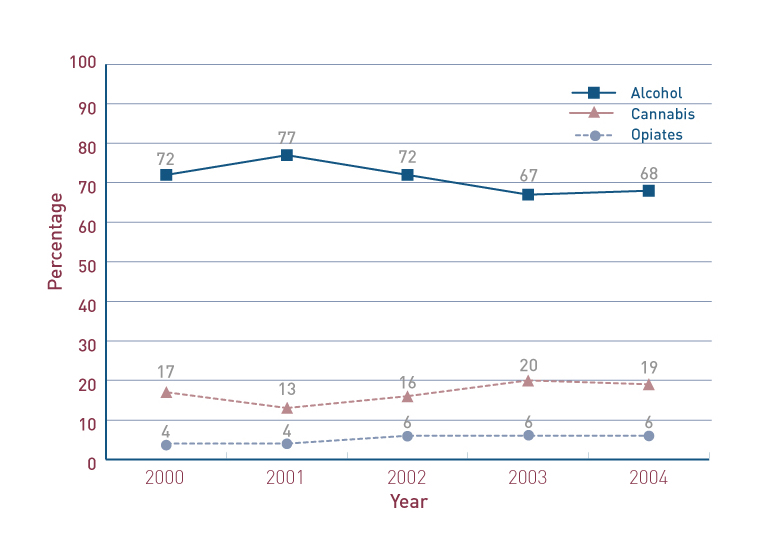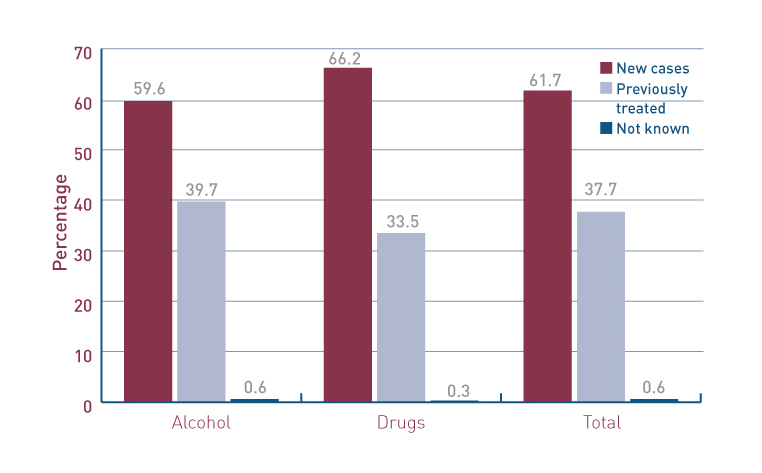Long, Jean and Kelly, Fionnola (2005) Substance misuse in the HSE South Eastern Area. Drugnet Ireland, Issue 15, Autumn 2005, pp. 17-18.
| Preview | Title | Contact |
|---|---|---|
|
PDF (Drugnet Ireland, issue 15)
- Published Version
402kB |
The Health Service Executive (HSE) South Eastern Area published its annual report entitled Data co-ordination overview of drug misuse 2004 1 in June 2005. The report comprises three sections: treatment services, education and prevention, and supply and control.
Treatment services
This section analyses data collected from statutory and voluntary drug and alcohol treatment agencies, acute general hospitals and psychiatric hospitals located in the HSE South Eastern Area. The data from the drug and alcohol treatment services are returned to the National Drug Treatment Reporting System. The key findings reported are:
· The total number of contacts with treatment services increased by 80 per cent over a five-year period, from 1,418 in 2000 to 2,549 in 2004 (Figure 1).1-5 Contacts with treatment services include those by clients continuing in treatment from the previous year, clients who were assessed but not treated, clients who were treated and concerned persons. The increase over the five-year period was evident among both male and female clients (Figure 1).
[for clearer images of the figures please see the PDF document]

Figure 1 Number of contacts with treatment services in the HSE South Eastern Area, 2000–2004
· In 2004, 8 per cent of all clients treated in the south-east were under the age of 18 years, while 32 per cent of clients attending the services were aged between 20 and 29 years.
· Alcohol, followed by cannabis, were the most common main problem substances for which treatment was sought from 2000 to 2004 (Figure 2).
· Of the clients who had used a drug, 40 per cent reported that cannabis was the first drug ever used.
· In 2004, 32 per cent of clients did not report using a secondary substance. The main substances of secondary use were alcohol, cannabis and ecstasy.

Figure 2 The five most common main problem drugs reported by cases treated in the HSE South Eastern Area, 2000–2004
· In 2004, almost 60 per cent of clients treated for alcohol and two-thirds of clients treated for a drug as their main problem substance were treated for the first time. (Figure 3).

Figure 3 Percentage of cases treated for problem alcohol or drug use in the HSE South Eastern Area in 2004
· In 2004, 111 (5%) cases had injected a substance. Of those who had injected, 39 (31%) had shared injecting equipment.
· In 2004, 151 concerned persons contacted both statutory and non-statutory services in the south-east. The majority of concerned persons were female (78%).
· Based on data received from the Hospital In-Patient Enquiry (HIPE) Scheme:
o There were 2,155 cases admitted to acute hospitals in the HSE South Eastern Area for one of the following diagnoses:
§ alcoholic psychosis
§ drug psychosis
§ alcohol dependence syndrome
§ drug dependence
§ non-dependent abuse of drugs.
o Seventy-three per cent of treated cases were male.
o In 2003, 28 per cent of all cases admitted to an acute hospital for a drug- or alcohol-related illness resided in Wexford.
o Over 70 per cent had a diagnosis of non-dependent abuse of drugs and almost one-fifth had a diagnosis of alcohol dependence.
· In 2003, the National Psychiatric In-Patient Reporting System reported that there were 541 admissions with an alcohol disorder and 116 admissions with a drug disorder to a psychiatric unit located in the HSE South Eastern Area.
Education and prevention
Community-based drugs initiatives were set up in the south-east to support local communities in increasing their awareness of drug-related issues and to assist in developing strategies to reduce the demand for drugs in the community. There were a total of 448 individual contacts with these services in 2004. The majority of contacts (53%) were from people concerned about someone else’s alcohol or drug use.
Supply and control
The information in this section focuses on the 530 cases referred to the probation and welfare services in the south-east for a drug- or alcohol-related offence during 2004. Of these 530 cases:
· Eighty-six per cent were male.
· Seven per cent were aged under18 years and 62 per cent were aged between 18 and 29 years.
· Waterford had the highest percentage by county, at 29 per cent.
· The majority (56%) were referred because of an alcohol-related offence.
Data presented in the Garda Siochana Annual Report 2003 indicate that 1,631 persons were prosecuted for drugs offences in the south-east in 2003. This represented 27 per cent of the national figures.
This overview is a comprehensive report that examines in detail alcohol- and drug-related data collected in the HSE South Eastern Area; such data is useful for planning responses in the area. It is recommended that other Health Service Executive areas follow the example of the south-east and publish such data on an annual basis.
1. Kidd M (2005) Data co-ordination overview of drug misuse 2004. Waterford: HSE South Eastern Area.
2. Data for the years 2000 to 2003 from the annual Data co-ordination overview of drug misuse reports compiled by M Kidd and published by the South Eastern Health Board between 2001 and 2004.
VA Geographic area > Europe > Ireland > Kilkenny
VA Geographic area > Europe > Ireland > Wexford
VA Geographic area > Europe > Ireland > Carlow
A Substance use and dependence > Prevalence > Substance use behaviour
VA Geographic area > Europe > Ireland > Tipperary
Repository Staff Only: item control page